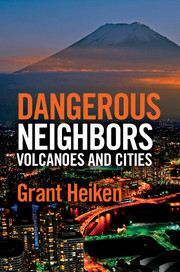Book contents
- Frontmatter
- Contents
- Preface
- Miscellaneous Frontmatter
- Introduction – dangerous neighbors: volcanoes near cities
- 1 Too many people and too many volcanoes – Naples, Italy
- 2 A full menu of volcanic hazards – Mexico City
- 3 “Like dangerous, yet undeniably beautiful women” – Guagua Pichincha and Cotopaxi volcanoes near Quito, Ecuador
- 4 Dangerous neighbors, but some bring gifts – Manila megacity, Philippines
- 5 “It’s part of the culture. Live with it!” – cities in Japan
- 6 Volcanic and proud of it – Auckland, New Zealand
- 7 Coffee, software, aircraft, and volcanic mudflows – Seattle, Tacoma, and Portland, USA
- 8 A tale of two cities – Akrotiri (island of Santorini, Greece) and Plymouth (island of Montserrat, Caribbean)
- 9 The dangerous neighbor is restless – how should a city respond?
- Recommendations for further reading
- Acknowledgements
- Index
8 - A tale of two cities – Akrotiri (island of Santorini, Greece) and Plymouth (island of Montserrat, Caribbean)
Published online by Cambridge University Press: 05 October 2013
- Frontmatter
- Contents
- Preface
- Miscellaneous Frontmatter
- Introduction – dangerous neighbors: volcanoes near cities
- 1 Too many people and too many volcanoes – Naples, Italy
- 2 A full menu of volcanic hazards – Mexico City
- 3 “Like dangerous, yet undeniably beautiful women” – Guagua Pichincha and Cotopaxi volcanoes near Quito, Ecuador
- 4 Dangerous neighbors, but some bring gifts – Manila megacity, Philippines
- 5 “It’s part of the culture. Live with it!” – cities in Japan
- 6 Volcanic and proud of it – Auckland, New Zealand
- 7 Coffee, software, aircraft, and volcanic mudflows – Seattle, Tacoma, and Portland, USA
- 8 A tale of two cities – Akrotiri (island of Santorini, Greece) and Plymouth (island of Montserrat, Caribbean)
- 9 The dangerous neighbor is restless – how should a city respond?
- Recommendations for further reading
- Acknowledgements
- Index
Summary
Scientists and others can learn for the future by observing the effects of past natural disasters on the world of Homo sapiens. One well-known historical event in the eastern Mediterranean involved a large volcanic eruption during the Bronze Age. The task of evaluating the effects of this ancient eruption is complex and many partial answers have come from the expertise of archeologists, geologists, atmospheric scientists, environmental scientists, historians, art historians, anthropologists, and classicists. Although these professionals usually work in separate worlds, the skills of all have been important in determining how a volcanic eruption and (possibly) the fate of a culture were linked.
This story begins with Akrotiri, an ancient town located on the island of Thira (now more popularly known as Santorini), which was most likely a stop along Minoan trade routes between mainland Greece and Crete. Buried by volcanic ash and pumice during the seventeenth century BCE eruption, Akrotiri is sometimes referred to as the “Pompeii of the Aegean.” Other than Akrotiri, it isn’t clear how many Bronze Age communities existed on Thira; however, a fresco preserved in the ruins of Akrotiri provides a hint that the island may have had several small towns.
- Type
- Chapter
- Information
- Dangerous Neighbors: Volcanoes and Cities , pp. 141 - 164Publisher: Cambridge University PressPrint publication year: 2013



